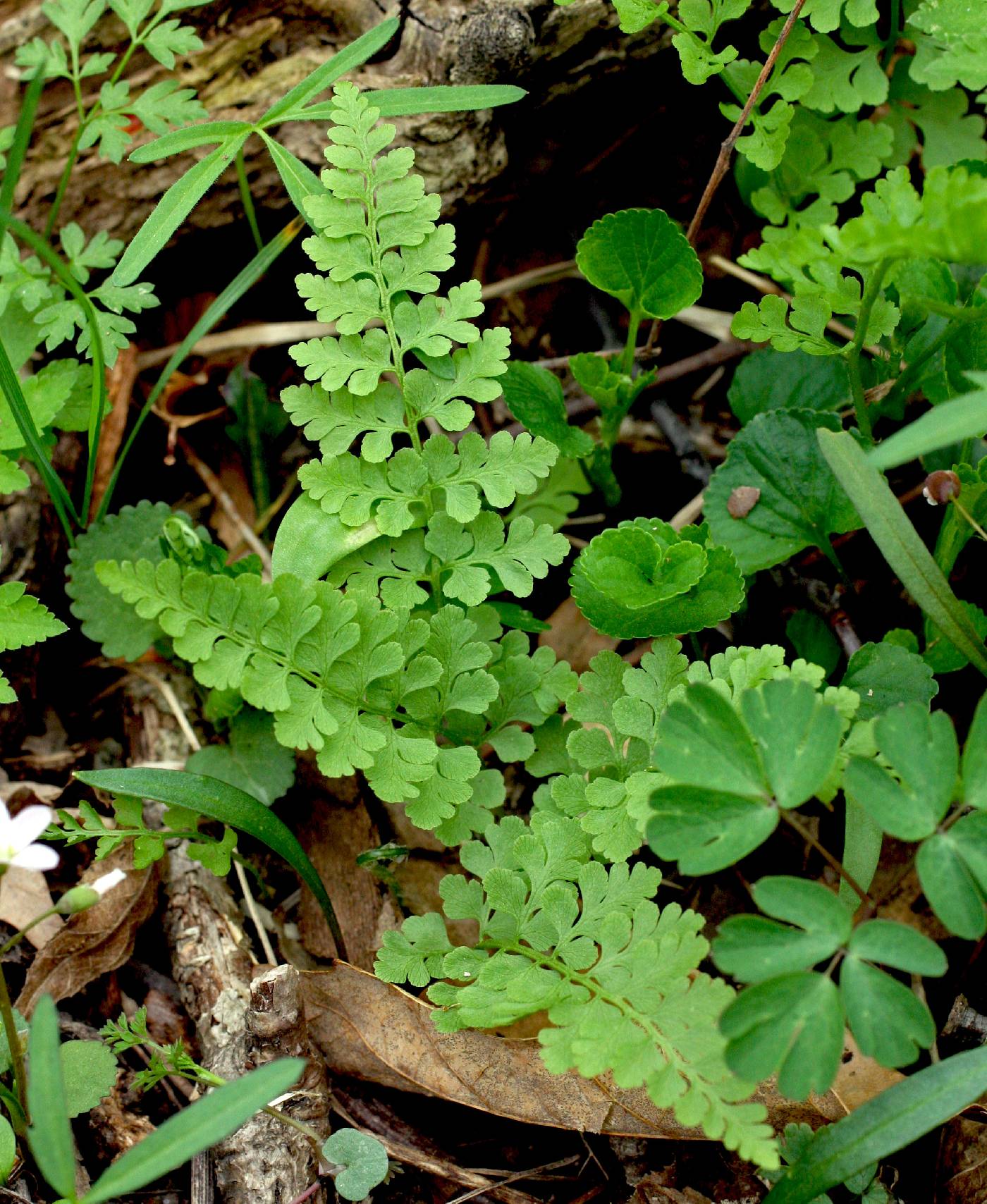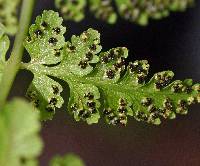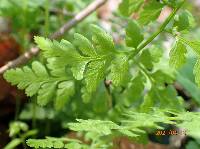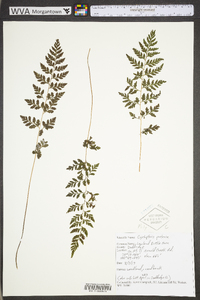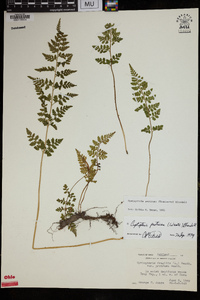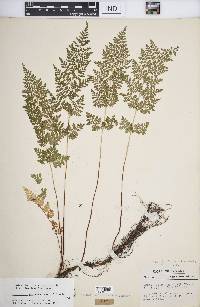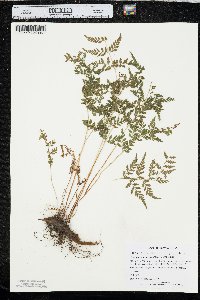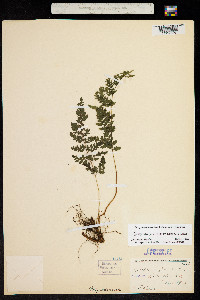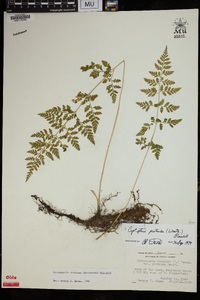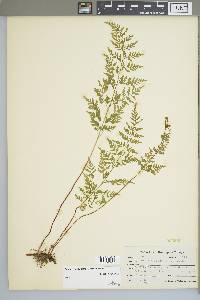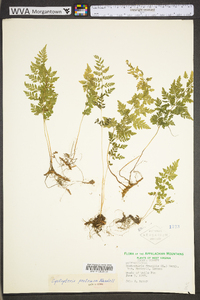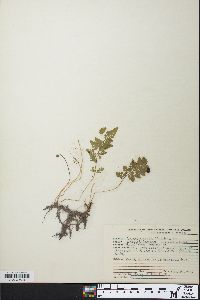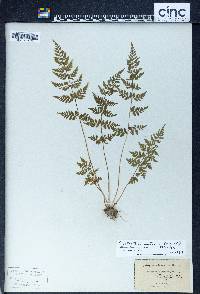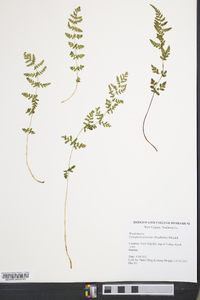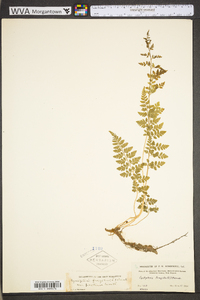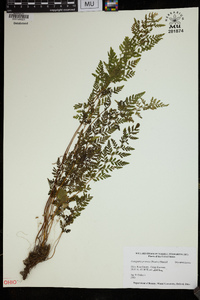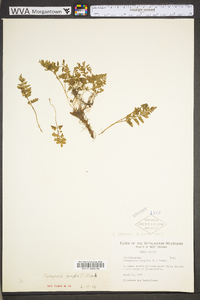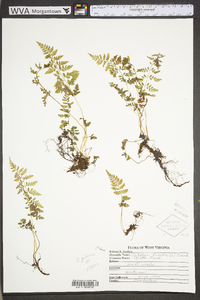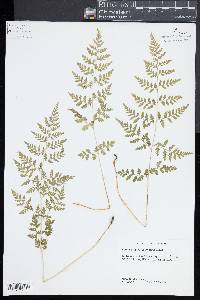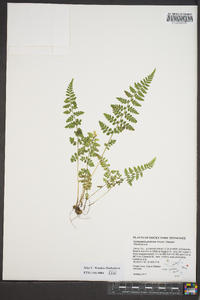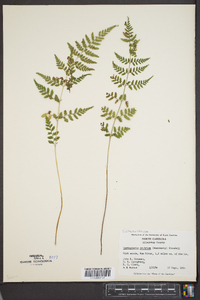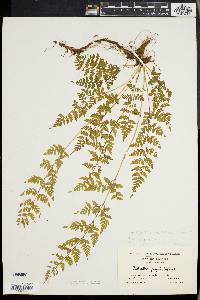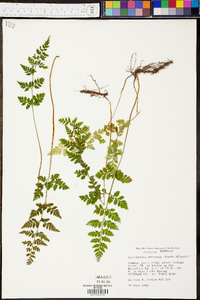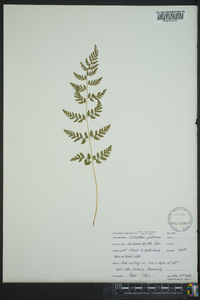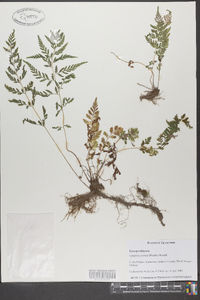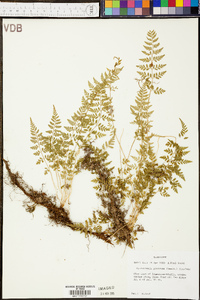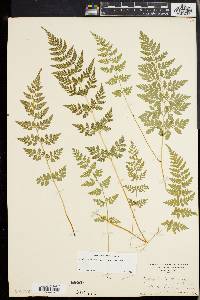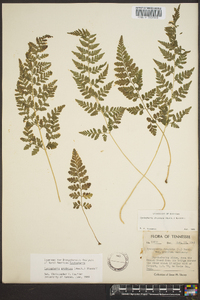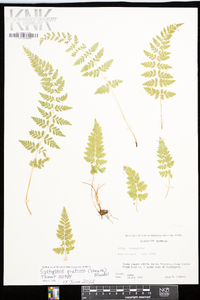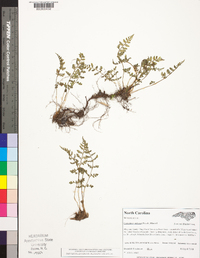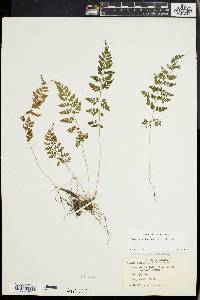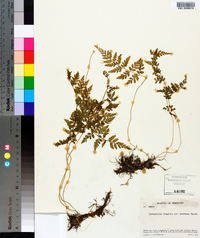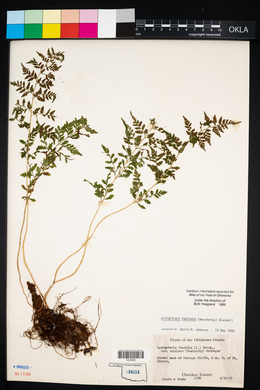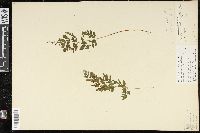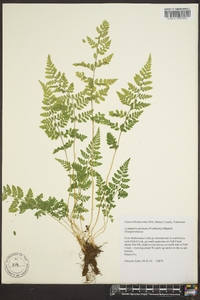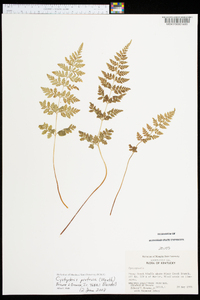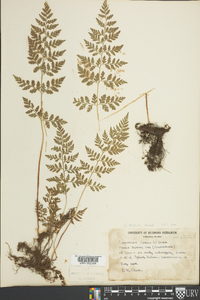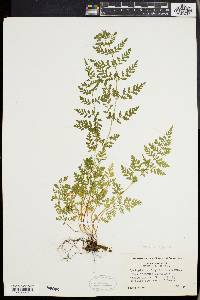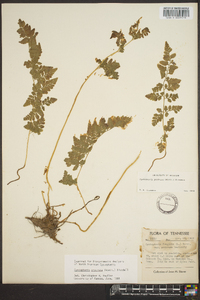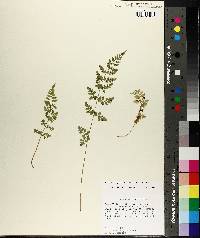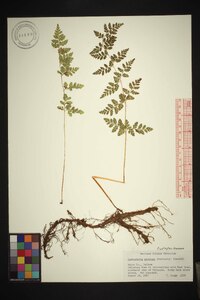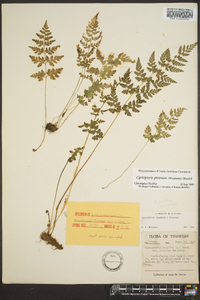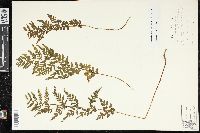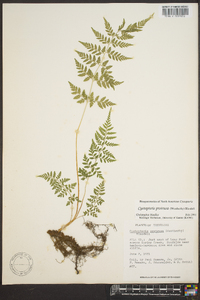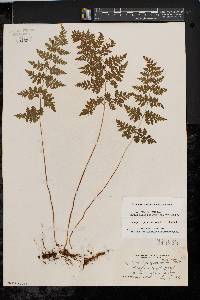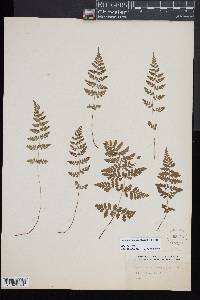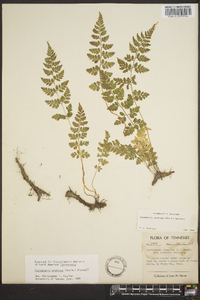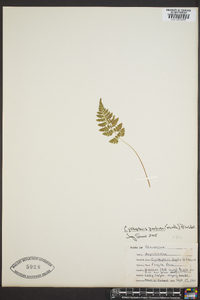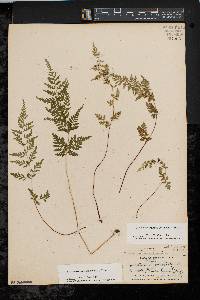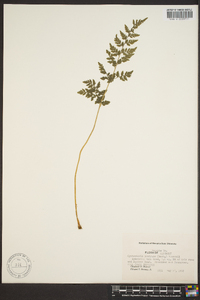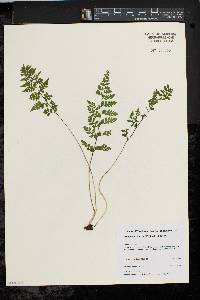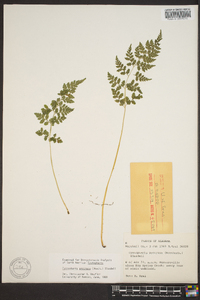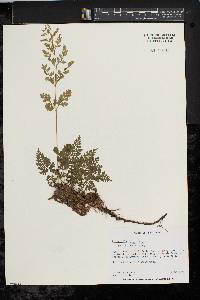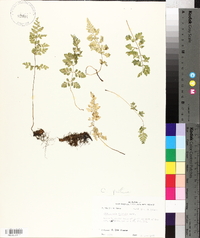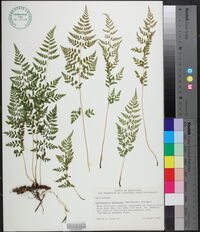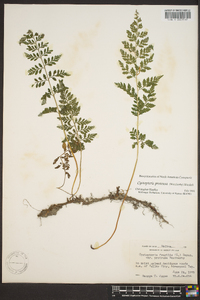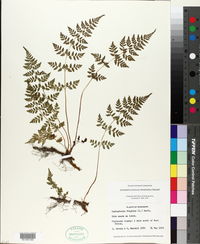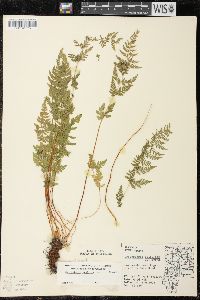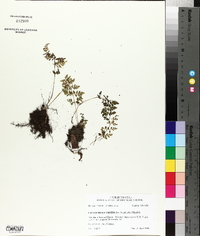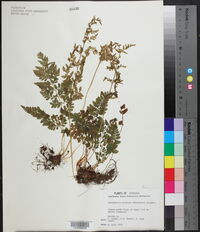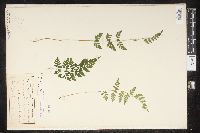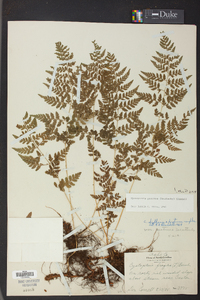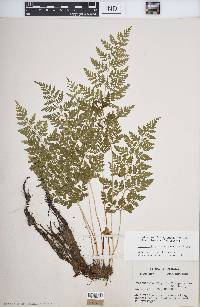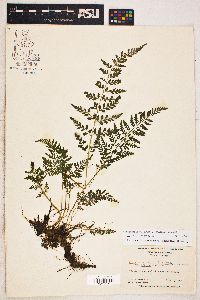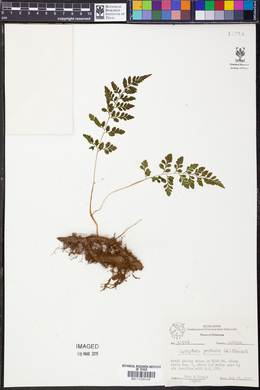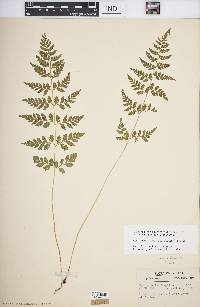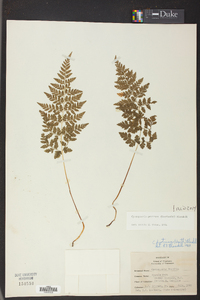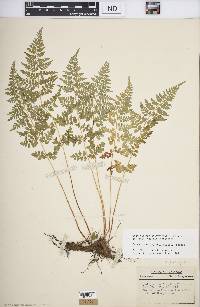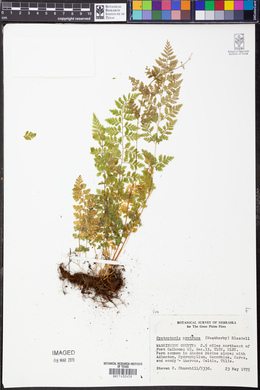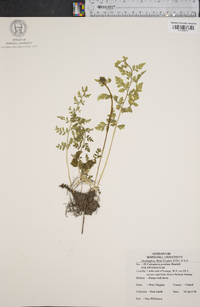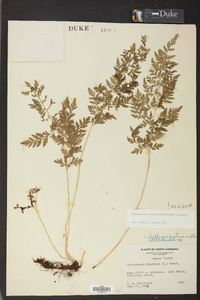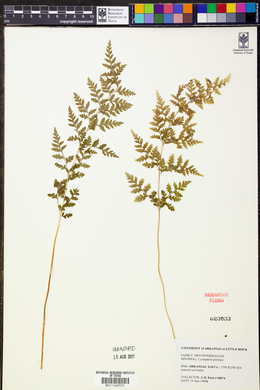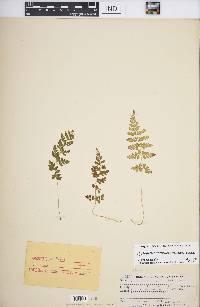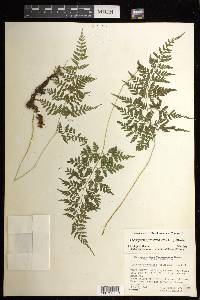
|
|
|
|
Family: Cystopteridaceae
Lowland Bladder Fern, more...southern bladder fern, lowland brittle fern, lowland bladderfern
|
Stems creeping, not cordlike, internodes long, 0.5--1 cm, with persistent petiole bases, covered with tan to golden hairs, especially toward apex; scales tan to light brown, ovate-lanceolate to lanceolate, radial walls thin, luminae tan, mostly crowded at stem apex. Leaves seasonally dimorphic, clustered 1 to several cm beyond persistent old petiole bases, especially in late spring and early summer, to 45 cm, bearing sori (earliest leaves smaller, sterile, coarsely divided, margins with rounded teeth; subsequent leaves larger, fertile, more finely divided, margins with sharply pointed teeth). Petiole mostly green to straw-colored throughout, shorter than or nearly equaling blade, base sparsely scaly. Blade ovate to elliptic, 1-pinnate-pinnatifid to 2-pinnate, widest at or just below middle, apex broadly acute; rachis and costae lacking gland-tipped hairs or bulblets; axils of pinnae lacking multicellular, gland-tipped hairs. Pinnae usually perpendicular to rachis, not curving toward blade apex, margins dentate to serrate; proximal pinnae pinnatifid to pinnate-pinnatifid, ± equilateral, basiscopic pinnules not enlarged, basal basiscopic pinnules stalked, base truncate to obtuse; distal pinnae deltate to ovate. Veins mostly directed into teeth. Indusia ovate to cup-shaped, lacking gland-tipped hairs. Spores spiny, usually 28--34 µm. 2 n = 84. Sporulating spring--summer. In soil of moist, deciduous forests; 0--1500 m; Ont.; Ala., Ark., Conn., Del., Ga., Ill., Ind., Iowa, Kans., Ky., La., Md., Mass., Mich., Minn., Miss., Mo., Nebr., N.J., N.Y., N.C., Ohio., Okla., Pa., S.C., Tenn., Va., W.Va., Wis. The terrestrial habit and characteristic stem features (golden hairs and protruding apex) readily distinguish Cystopteris protrusa from other Cystopteris species with which it may be sympatric ( C . tenuis , C . tennesseensis , and C . bulbifera ). Cystopteris tennesseensis and C . tenuis are allotetraploids that have C . protrusa as one parent. The other progenitor for C . tennesseensis is C . bulbifera , and a presumably extinct diploid is proposed here as the progenitor for C . tenuis . When C . protrusa is sympatric with either of these derived tetraploid species, sterile triploids are often produced. In addition, there are sterile autotriploids within C . protrusa (C. H. Haufler et al. 1985).
Perennial fern 10 - 45 cm tall Leaves: clustered, stalked, green, delicate, thin, deciduous (dying back in winter), 5 - 40 cm long, widest at or just below middle, in outline egg-shaped to elliptic with broadly pointed tip, but pinnately compound. The main "midrib" (rachis) never has gland-tipped hairs or bulblets. Leaves appearing in late spring and early summer, the earliest smaller and sterile with more rounded teeth. Rhizome: long-creeping, 2 - 4 cm long, internodes long (0.5 - 1 cm), remnant leaf stalk bases encircling tip, which has sparse tan to light brown, egg- to lance-shaped scales, but otherwise densely covered with long, tan to golden hairs. Leaf stalks: clustered 1 - 4 cm behind tip of rhizome, mostly green to straw-colored, shorter than or equaling leaf blade, and sparsely scaly at base. Spores: 64 per sac, brownish, all of one kind, single-sectioned (monolete), usually 28 - 34 microns long, oblong or kidney-shaped, and spiny. Produced seasonally (not on first leaves), the spores give rise to the gametophyte (the sexual phase of the plant), which is small, green, heart-shaped, hairless or often with glands or hairs, and sits above the ground. Similar species: Cystopteris protrusa is unique among our species in the genus due to its obvious, golden, long hairs on the rhizome and very base of leaf stalks, However, C. protrusa is probably most similar to C. fragilis since the leaves are similarly shaped and toothed, but that species (as our others) has its leaves clustered at the rhizome tip, spores are typically produced on all the leaves, and the spores are larger (39 - 60 microns). Differing further is C. tenuis, which has its leaf divisions (pinnae) positioned at an acute angle (less than ninety degrees) to the rachis, the edges of the final leaf segments or lobes have round teeth, and the spores are usually larger (39 - 60 microns). Also incredibly similar is C. tennesseensis since it was derived from hybridization of C. protrusa (the other parent being C. bulbifera). However, it can be distinguished since it occasionally has bulblets along the rachis; it often has scattered gland-tipped hairs along its rachis, costae, segment midribs, pinnae axils, and spore-cluster coverings (indusia); the leaf blades are more triangular and usually widest near the base with a longer pointed tip; almost all the leaves produce spore-sac clusters (sori); and the spores are usually larger (38 - 42 microns). The remaining species of Cystopteris in the Chicago Region, C. bulbifera, differs by having reddish leaf stalks when young, a thick covering of glandular hairs on many of the leaf portions, the leaf blades are more triangular and widest near the base, and the rachises and costae usually have bulblets. Habitat and ecology: Common, in mesic woods. Occurence in the Chicago region: native Notes: Our most common species of Cystopteris, this fern can be quickly recognized by the obvious, long, golden hairs at the base of the leaf stalks and upper half of the rhizome. This species has often been referred to the species name C. fragilis, and more particularly as a variety of that species, C. fragilis var. protrusa. Etymology: Cystopteris comes from the Greek words cystis, meaning bladder, and pteris, meaning fern. Protrusa means "to push forward", probably in reference to the rhizome tip being1 - 4 cm forward of the leaf stalks. Author: The Field Museum Rhizome long-creeping, sparsely scaly but densely villous, the growing point produced 2-4 cm beyond the often more scattered lvs; petiole greenish or stramineous except often at the very base; minor axes of the blade with scattered glands; veins typically running into marginal teeth; lowermost pinnules mostly cuneate at the base, and often short-petiolulate; indusium ca 0.5 mm, usually entire; 2n=84; otherwise much like no. 1 [Cystopteris fragilis (L.) Bernh.]. Abundant in mesic woods; N.Y. and s. Ont. to s. Minn., s. to Ga., Ala., La., and e. Kans. (C. fragilis var. p.) Gleason, Henry A. & Cronquist, Arthur J. 1991. Manual of vascular plants of northeastern United States and adjacent Canada. lxxv + 910 pp. ©The New York Botanical Garden. All rights reserved. Used by permission. From Flora of Indiana (1940) by Charles C. Deam The Cystopteris fragilis species complex has been restudied by C.A. Weatherby. He has recently described a new variety to which, in my opinion, all or most all or our specimens belong. It is described as follows: Rootstock creeping, only sparsely beset with bases of old fronds, the growing point hardly paleaceous, produced 2-4 cm beyond the fronds of the season; well-developed blades nearly bipinnate-pinnatifid, 11-22 cm long, 5-11.5 cm wide, pinnae ovate to ovate-lanceolate, acute, pinnules toward the base of the pinnae deltoid-ovate to ovate-lanceolate, subacute, usually shortly but distinctly petiolulate, deeply pinnatifid into oblong, obtuse lobes; in juvenile or depauperate blades less lobed and more obtuse; indusium about 0.5 mm long, shallowly lobed or nearly entire at apex. Southern New York, south in the piedmont and the mountains to Alabama, west to Minnesota and Missouri." My specimens have been examined by two fern specialists and they agree that most of them belong to this variety and some can not be determined with certainty. A form of this species with large, abundant sori has been named f. magnasora Clute (Fern Bull. 9: 65. 1901). The true species has a range to the north of Indiana. In order to refer specimens to their correct variety and form it is usually necessary for them to have the indusium and rootstock which most of our specimens lack. Since it is impossible to correctly name all of our specimens I have decided that it is best to regard all of them as belonging to a species complex and they are so indicated on the map. |

